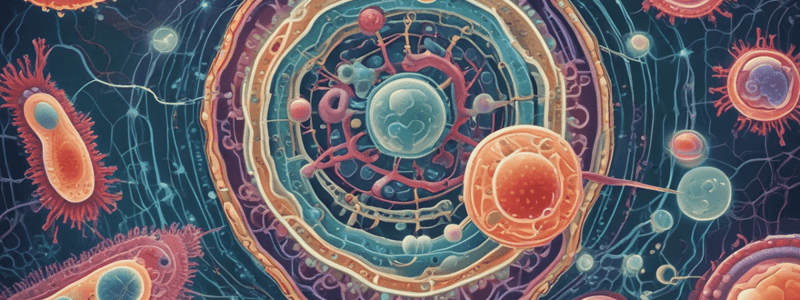Podcast
Questions and Answers
What is the function of capsules on bacterial surfaces?
What is the function of capsules on bacterial surfaces?
- To aid in bacterial movement
- To provide a protective covering against phagocytic cells (correct)
- To adhere to surfaces (correct)
- To produce toxins
What is the primary function of flagella in bacterial cells?
What is the primary function of flagella in bacterial cells?
- To aid in bacterial movement and chemotaxis (correct)
- To provide structural support to the cell
- To facilitate nutrient uptake
- To produce toxins
What is the primary function of endospores?
What is the primary function of endospores?
- To facilitate nutrient uptake
- To provide a survival strategy under sub-optimal conditions (correct)
- To aid in bacterial movement
- To produce toxins
What type of toxins cause cell lysis?
What type of toxins cause cell lysis?
What is the term for the directed movement of bacteria towards or away from chemicals?
What is the term for the directed movement of bacteria towards or away from chemicals?
What is the primary function of exotoxins?
What is the primary function of exotoxins?
What is the term for toxins that affect neurotransmitter release?
What is the term for toxins that affect neurotransmitter release?
What is the term for the excessive immune response caused by some toxins?
What is the term for the excessive immune response caused by some toxins?
What is the primary function of fimbriae in bacterial cells?
What is the primary function of fimbriae in bacterial cells?
What is the main target of chemotherapy in bacterial infections?
What is the main target of chemotherapy in bacterial infections?
What is the name of the major molecule in the bacterial cell wall?
What is the name of the major molecule in the bacterial cell wall?
What is the purpose of the cell envelope in bacterial cells?
What is the purpose of the cell envelope in bacterial cells?
What is the result of fimbriae preventing the flushing action of saliva, urine, etc. in humans and animals?
What is the result of fimbriae preventing the flushing action of saliva, urine, etc. in humans and animals?
What is the main difference between Gram positive and Gram negative bacteria?
What is the main difference between Gram positive and Gram negative bacteria?
Flashcards are hidden until you start studying
Study Notes
Bacterial Cell Structures
- The lecture focuses on prokaryotic cells, with emphasis on components related to infection severity and bacterial cell protection.
- The cell envelope and cell wall are crucial for protecting the cell's internal environment and providing shape and rigidity.
Gram Staining and Bacterial Morphologies
- Understand the difference between Gram positive and Gram negative bacteria.
- Familiarize yourself with various bacterial morphologies.
Bacterial Cell Surface Structures
- Fimbriae are short protein structures that enable bacteria to adhere to surfaces and prevent flushing action.
- Capsules are outer coverings of polysaccharide that provide partial protection from phagocytic cells and aid in biofilm formation.
Internal Bacterial Structures
- Endospores are bacterial survival strategies that occur when conditions are sub-optimal, allowing vegetative cells to convert to dormant, non-growing structures.
- Endospores are highly resistant to heat, chemicals, and radiation and can be produced by only two genera of bacteria (Clostridium, Bacillus).
Bacterial Movement
- Bacterial motility is provided by flagella, which are long, thin hair-like structures attached to the bacterial cell.
- Flagella act like propellers to propel bacteria forward or backward, allowing them to move towards desirable environmental conditions and away from undesirable chemical stimuli.
Chemotaxis
- Flagella can direct the cell towards desirable environmental conditions (food) and away from undesirable chemical stimuli (antibiotics) through chemotaxis.
- In the absence of a chemical stimulus, the cell swims randomly (tumble), and in the presence of an attractant, the cell moves towards the gradient of the attractant (run).
Secreted Bacterial Products
- Exotoxins are toxic proteins actively secreted by organisms during growth, which can travel from the site of infection to distant sites via blood and tissues.
- Exotoxins can be categorized based on their mechanism of action, including cytotoxins, neurotoxins, enterotoxins, and superantigens.
Studying That Suits You
Use AI to generate personalized quizzes and flashcards to suit your learning preferences.




